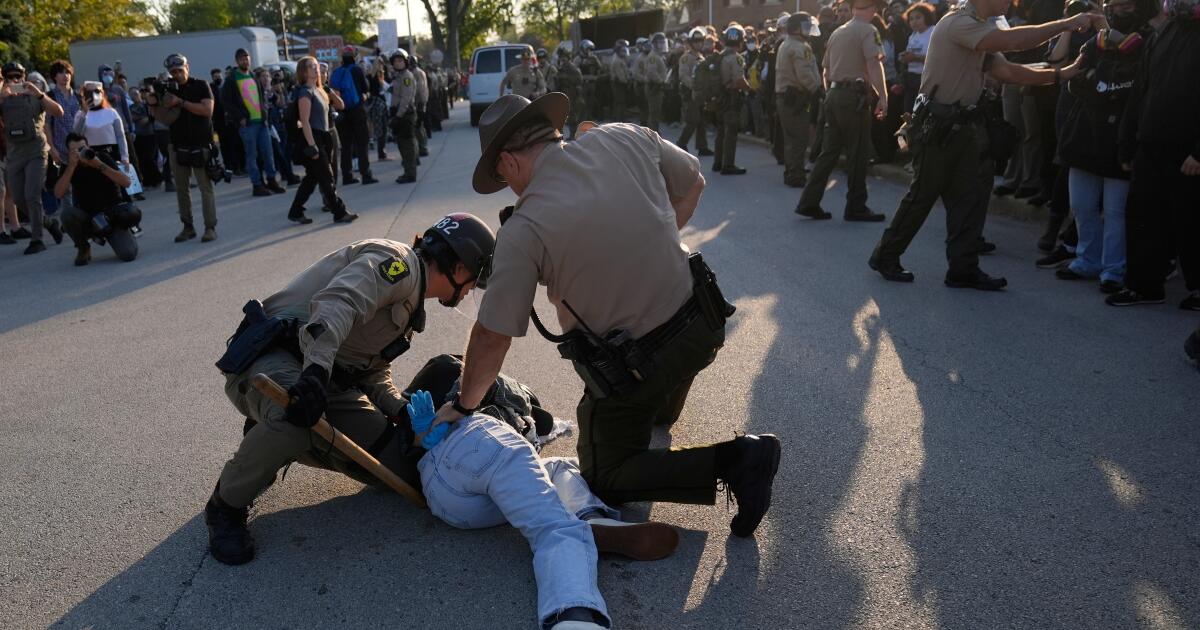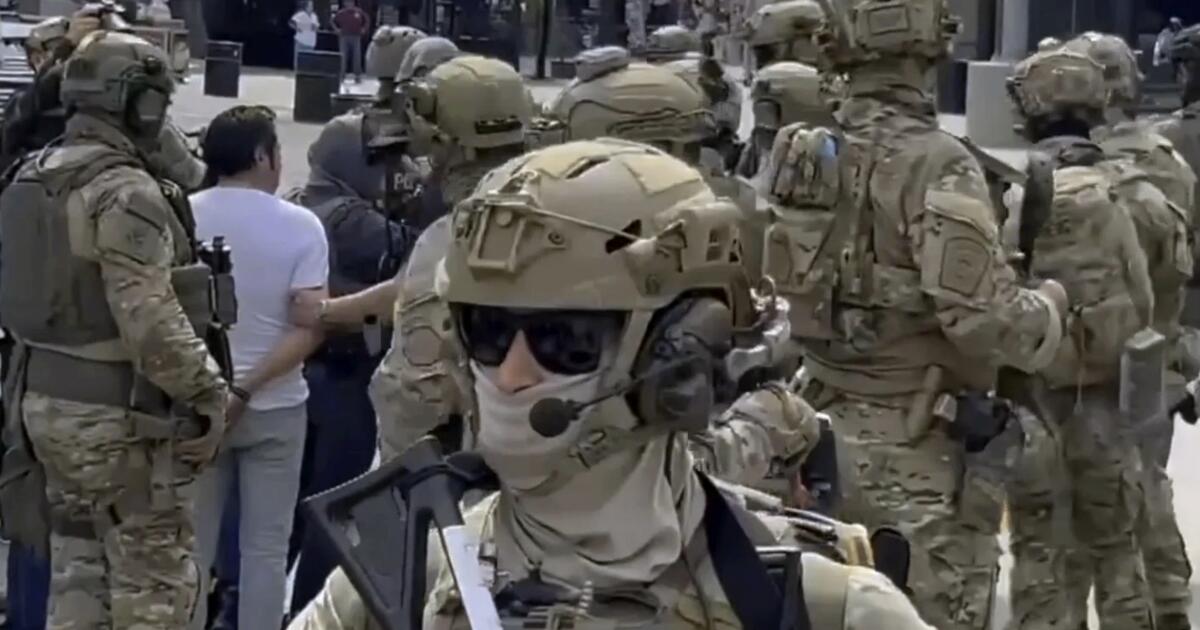If you thought Jimmy Kimmel saved free speech, think again.
To hear President Trump tell it, no one, especially law enforcement officers, is safe from the dangers caused by opposing his policies — and he’s ready to do something about it.
“This political violence is not a series of isolated incidents and does not emerge organically,” Trump wrote in a new executive order. “A new law enforcement strategy that investigates all participants in these criminal and terroristic conspiracies — including the organized structures, networks, entities, organizations, funding sources, and predicate actions behind them — is required.”
Of course, despite his menacing tone, I agree with Trump that politically motivated violence against law enforcement — or anyone, be it Charlie Kirk or immigrant detainees — is reprehensible and completely unacceptable.
The deadly shooting in Dallas this week, which Trump referred to in the order, is a tragedy and any political violence should be prosecuted to the fullest extent of the many laws on the books that protect our public servants, and the public at large.
But criticizing government overreach is not inciting violence, and calls for Democrats to stop attacking Trump’s policies are just calls to silence dissent — one more attack on free speech at a moment when it’s clear this administration is intent on demolishing opposition.
If we are serious about preventing further political violence, trust in our justice system must be a priority. And you know what’s really eroding trust? Scary masked agents on our streets who refuse to even say what agency they work for.
In recent days, about 6,700 federal workers from agencies outside of ICE have been pulled into its immigration mission, according to the non-partisan Niskanen Center.
The anxiety brought on by an unaccountable and unknowable federal force, one that is expected to grow by thousands in coming years, is what is raising the temperature in American politics far more than the words from either side, though I am not here to argue that words don’t have power.
Ending the fear that our justice system is devolving into secrecy and lawlessness will reduce tension, and the potential for violence. Want to protect officers — and our democracy?
Ban masks.
“Listen, I understand that it being a law enforcement officer is scary,” former Capitol police officer Harry Dunn told me Wednesday during a press event for the immigration organization America’s Voice.
Dunn was attacked, beaten and called racial slurs during the political violence on Jan. 6, 2021.
“Nobody ever signed up to be harassed, to be targeted. That should never happen,” he said.
But Dunn said he’d never don a mask, because it harms that public trust, that mission to serve and protect.
When officers cover their faces and demand to be nameless and faceless, “They are terrorizing … with something just as simple as a mask,” he said.
Which is why California just passed a law attempting to ban such masks, effective next year — though it will likely be challenged in court, and federal authorities have already said they will ignore it.
“We’re not North Korea, Mr. President. We’re not the Soviet Union. This is the United States of America, and I’m really proud of the state of California and our state of mind that we’re pushing back against these authoritarian tendencies and actions of this administration,” said Gov. Gavin Newsom before signing the bill.
The argument in favor of masks is that some officers are afraid to do their jobs without them, fearing they or their families will be identified and targeted. The Department of Homeland security claims that assaults on officers are up 1,000%, though it’s unclear what data produced that figure.
“Every time I’m in a room with our law enforcement officers, I’m talking to them before they go out on our streets, I’m just overwhelmed by the fact that all of these young men and women have families that they all want to go home to,” Homeland Security Secretary Kristi Noem said. “(P)eople like Gavin Newsom are making it much more dangerous for them just to go do their job.”
Federal immigration authorities are not required by their agencies to wear masks. Not ski masks, not balaclavas, not even medical masks — which many officers refused to don even during the pandemic.
Like the choice to become a federal law enforcement officer, hiding their identity while doing their duty is a personal decision. Some agents aren’t masked. There is no rule to bring clarity, only leaders pushing the false narrative that protecting officers is impossible at this moment of unrest, and they must do what they see fit to protect themselves.
Which raises the question, why not help all officers feel safe enough to go unmasked, rather than allowing some to work in a fearful environment? Surely, if some officers feel safe enough to go about their duties in a regular fashion, there must be something their leaders can do to promote that sense of strength among the ranks rather than cave to the timidity of anonymity and helplessness?
“Things can be done,” Gabriel Chin told me. He’s a professor of law at UC Davis and an expert on criminal procedure.
“The nice thing about being a law enforcement officer is if somebody does something illegal to you, you have the resources to investigate and have them criminally charged,” Chin said. “But you know, this kind of thing has happened to judges and police and prosecutors, apart from ICE, for some years, unfortunately, and yet we don’t have masked judges and masked prosecutors.”
In 2020, for example, the son of New Jersey judge Esther Salas was shot and killed by a self-described men’s rights lawyer who came to her front door and had a list of other judges in his car.
Salas did not respond by demanding judges become faceless. Instead, she successfully lobbied for greater protection of all judges nationwide.
U.S. District Judge John Coughenour, a Republican-appointee who was the first to block Trump’s executive order axing birthright citizenship, has spoken publicly, along with five other federal judges, about continuing threats facing his brethren, including both a recent “swatting” incident and a bomb threat against him and his family.
“It’s just been stunning to me how much damage has been done to the reputation of our judiciary because some political actors think that they can gain some advantage by attacking the independence of the judiciary and threatening the rule of law,” he told Reuters — an attack coming from the right.
Speaking at the same event, Chief U.S. District Judge John McConnell of Rhode Island said that like many other judges, he’s been harassed with pizzas being sent to his home address — including “one in the name of Daniel Anderl,” Reuters reported. That’s the name of Salas’ murdered son.
Just this week, a Santa Monica man was arrested and charged with doxxing an ICE lawyer.
But McConnell’s face is still visible when he takes the bench, as is Coughenour’s and every other judge and prosecutor. They face those who come before them for justice, because that is what justice requires.
What ultimately keeps them — and our system — safe is our collective belief that, even if imperfect, it has rules, stated and implied.
The most basic of these is that we face each other, even if we are afraid.

